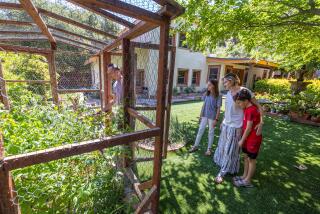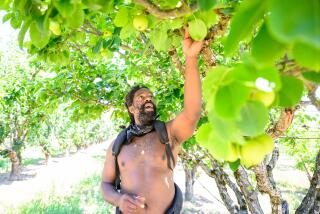Down on the Farm : Lifestyle: The 75-acre Bathgate Ranch in San Juan Capistrano, established in the 1920s, stands as testimony to the area’s agricultural roots.
- Share via
SAN JUAN CAPISTRANO — The traditional Sunday drive disappeared from Orange County about the time the countryside did. Now the scenery is jetliners, auto dealers, shopping malls and office towers.
But when you reach the northern outskirts of this city, your jaded senses are jarred. After miles of industrial parks and housing tracts, you suddenly come upon a time bubble from the ‘20s that somehow has risen to the present.
Across the railroad tracks, beyond the dirt-banked creek, is an ancient barn more nostalgic than a hardware store calendar. Inside are still a few harnesses for horses. Outside, a four-legged bathtub sits under a tree. Old implements rust at the edge of a clearing.
Orange, avocado and persimmon trees stretch to the distant hillside, punctuated here and there by weathered wind machines, a tractor shed and a wooden water tower.
Where the trees end, two houses stand, old, unpretentious and dignified. Real farm houses, the kind that started small and grew each time a baby was born.
It all looks real and alive, not restored and preserved. But how could it be? Is this the Twilight Zone?
The answer comes first as a rumble from within the trees, then as a roar as a vintage Ford tractor emerges between rows. All morning it has been plowing under the mustard that has grown in the gaps, and the tractor’s radiator is caked with the delicate yellow flower petals.
The farmer kills the engine, which sputters and spews a small geyser of steam. He dismounts and brushes the petals away from the radiator.
He wears a John Deere cap. Cinching his jeans is a belt with a brass “Sunkist” buckle. His fingers are thick from work. He is lined but hard. He could be 50 years old--or 80. He says he’s 67.
He is Billy Bathgate, who owned the name long before it became a novel and movie title and he’s not about to change it. In Bathgate’s world, things don’t change all that much. His father’s name was Bill. His grandfather’s name was Bill. His son is Bill, and so is his daughter’s boyfriend. “We even had a horse named Bill,” he says.
His family worked this land before he was born. He grew up here, and his children grew up here. Two of them, a city planner and a theatrical stage manager, still live here.
Bathgate’s 75-acre ranch was nothing special in the 1940s, when Orange County had about 75,000 acres of citrus orchards, enough to keep dozens of packing houses busy. Most have been overlaid by housing and commercial development, and nowadays there are only about 4,000 acres of citrus, overwhelmingly owned by corporations.
That the Bathgate Ranch has entered the ‘90s virtually unchanged makes it unique.
How did Bathgate preserve his ranch life as long as he did? The ironic answer is that it persisted in spite of Bathgate, who says he never wanted to be a farmer and wanted to sell the ranch as far back as the late ‘40s. “I got stuck,” he says.
“People think it’s all rosy (on a farm). It’s not as good as it looks from the outside. It’s good to look at.
“I like the life; I don’t like the gambling. Farmers are gamblers. You put forth a lot of money and effort and maybe get nothing for it.”
Nothing? “Yeah, well, it’s a hard deal to move out,” he admits. “Every bit of junk has a memory attached to it.”
The tiny barn, now used for storage, reminds him of the man who came in 1924 and raised the barn in one day. Steep-banked Oso Creek reminds him of 1938 when his uncle drowned there.
The old house on the north end reminds him of the hired man, another Bill, who came to the ranch a young man and stayed until he died in his 80s.
Bathgate’s father and uncle, who had been farming on leased land at Emerald Bay, bought the San Juan Capistrano property in 1924 and started building their houses there. They weren’t quite finished by the time Billy was born, but by age 2 weeks, Bathgate was living on the ranch, where he grew up an only child.
He served as an instructor in the Army Air Corps during World War II, then in the late ‘40s graduated from USC with a degree in mechanical engineering. He wanted an engineering job in some rural setting. “I’d lived in the city long enough to know I didn’t like it.”
But Bathgate’s father fell ill, and the only son was summoned to the farm to help out. When Bathgate’s father died, his mother and widowed aunt “asked me to do what I could to keep it going. It was security, I guess. There was an income--not a great income.
“We should have sold the property right when my father died. I think we would have been better off, financially. It’s a poor position to get into--to let sentiment influence what you do.”
Economics had more to do with it than sentiment. Railroad tracks and a creek separated the ranch from the only nearby road, Camino Capistrano, providing two barriers to the easy access developers look for in land.
In 1969, despite the reluctance of his mother, Bathgate and relatives signed a lease with a developer that included an option to buy the property. While the developer pondered whether to actually buy the land, he paid the property taxes and paid the Bathgates $1,000 per acre per year. With that kind of subsidy, Bathgate continued to farm. “You can farm forever that way.”
And it seemed he would, for the developer’s vision of a golf course on the land faded and died. The developer optioned his option to another developer, who proposed a housing tract. But that plan was withdrawn when the developer was swallowed up by another firm.
Eventually, the option was bought second-hand by Robert H. Schuller’s Crystal Cathedral Ministries, which had acquired the adjoining Rancho Capistrano land just to the north. Confident that it could obtain city approval for a cemetery on the Bathgate property, the ministries bought the land in 1989 for a reported $4.5 million.
The price the Bathgates were to receive had been determined back in 1969 when they signed the original option. They received about $1.7 million to be divided among seven Bathgate relatives.
Billy Bathgate says his share went to buy four houses in Mission Viejo, but he has rented them all. He continues to live on and work the ranch, waiting for the call from the ministry that it’s time to make way for the construction crews. He and his wife Pat still haven’t decided where they’ll go, he says.
“It’s easier for the kids to leave the ranch,” he says. “Two of them have already.”
But they return often. The eldest, Susanne Bathgate, an obstetrician and gynecologist in Washington, D.C., flies in four or five times a year.
Of course she has memories, she says.
Like walking home in the ‘60s from the school bus stop while chewing sour grass or picking and eating asparagus sprouts. Like taking her wagon and going on ladybug hunts in the orchard. Or riding her pony the few yards over to her grandmother’s, who served lemonade and cookies from the porch. Or staying overnight at a friend’s because the flooded creek or muddy road blocked the way home.
“I think we knew the way we lived was a little bit different,” she says. “I guess I always knew since I was 13 or so that one day the ranch would not be ours. I tried to enjoy it while I could.
“The surrounding area has changed so drastically, even in the time I’ve been in Washington, that it’s not like I’m losing the same place I left 10 years ago.”
The Bathgates’ time bubble seems sure to burst before long; a spokesman for the owner says that if negotiations go well with city officials, cemetery construction could begin early next year.
The city, on the other hand, is trying to preserve at least some of its remaining old-time farming heritage.
Using money from a local bond issue passed in 1990, the city last year bought the 56-acre Kinoshita farm in the city’s southwestern section and have contracted with the Kinoshita family to continue working it.
The city has entered escrow on the 42-acre Swanner Ranch just south of the Bathgates’. Other farming properties in that area are being considered for purchase.
The city’s open space advisory committee is holding hearings on what to do with the Swanner property. Members have studied proposals ranging from leaving it as it is to developing parts as equestrian centers and ball fields. So far, the committee has expressed a preference to preserve the farm house and maintain the small Christmas tree farm and better areas of the citrus orchard.
“We want to be able to come up with things that can be self-supporting,” said Ron Sievers, director of public lands and facilities. “For instance, if we maintain agriculture on the property, it must be productive.”
It’s all too late for the Bathgate Ranch, productive or not. Billy Bathgate continues to do the chores and ponder where he’ll go after the only home he’s known is buried in a cemetery.
Would it have been better not to sell the ranch?
“Yes,” says the man who never wanted to be a farmer.
Was that possible?
“No.”
More to Read
Sign up for Essential California
The most important California stories and recommendations in your inbox every morning.
You may occasionally receive promotional content from the Los Angeles Times.













